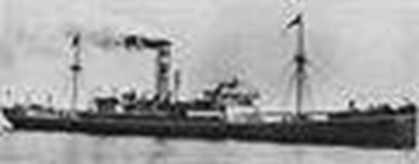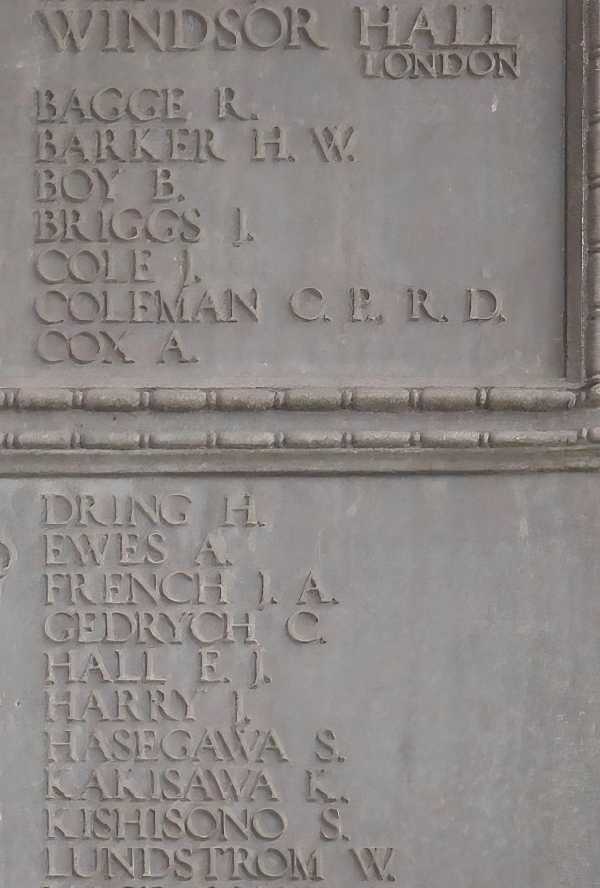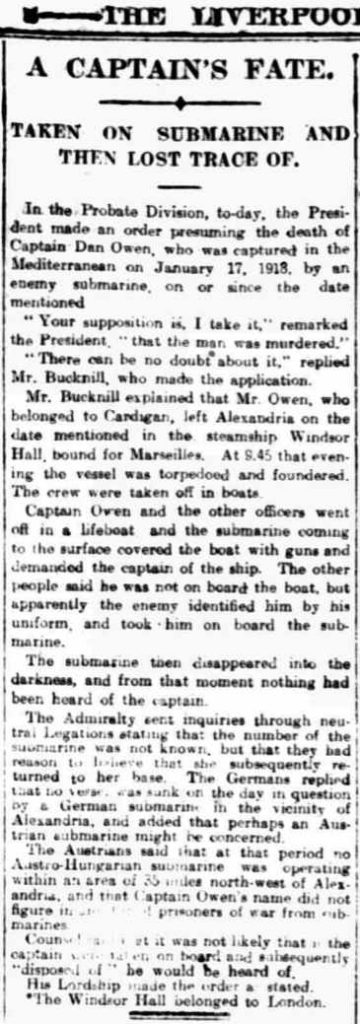Horace Ward Barker
He was a deck boy on the SS Windsor Hall (London), Mercantile Marine. He died on the 17th January 1918 aged 15. He is commemorated at the Tower Hill Memorial.
Born in December 1902 he was the son of Alfred and Emily Eilleen Barker, of St John’s Road, Epping. His father was a railway clerk. Horace enlisted in the Mercantile Marine and became an apprentice Deck Boy, on the SS Windsor Hall, a defensively armed merchantman of 3,693 tons. On 17th January 1918 the Windsor Hall was torpedoed and sunk in the Mediterranean Sea, 45 miles north-west of Alexandria. The ship’s captain was taken prisoner, but Horace Barker was one of 27 crew who lost their lives. He was presumed to have drowned. At just 15 years he was the youngest of Loughton’s war dead, and indeed the youngest of Loughton scholars to die.
The 1911 census shows the family lived in St John’s Road, Epping. Alfred Barker was head of household 39 a railway clerk, his wife Emma 36, they had been married for 14 years. They had three sons Frank Ernest 3, Horace Ward 8, Lewis Ward 4 and a daughter Irene Ward 6.
SS Windsor Hall, built by W. Doxford & Sons, Ltd Sunderland in 1911 and owned at the time of her loss by Hansen Bros., Ltd, London, was a British steamer of 3,693 tons. On January 17th, 1918, Windsor Hall, on a voyage from Karachi to Marseille with a cargo of barley and grain, was sunk by the German submarine UB-66 (Fritz Wernicke), 45 miles NW Alexandria. 27 persons were lost. UB-66 was never heard of again after this action.
People on board SS WINDSOR HALL123 1. BAGGE, RICHARD (18), Wireless Operator, SS Windsor Hall, Mercantile Marine, 1899 ~ †17/01/1918, Son of Richard and Catherine Bagge (nee O’Leary), of Main St., Macroom, Co. Cork. Born at Kinsale, Memorial: Tower Hill Memorial 2. BARKER, HORACE WARD (15), Deck Boy, SS Windsor Hall, Mercantile Marine, †17/01/1918, Son of Alfred and Emily Ellen Barker, of St. John’s Rd., Epping, Essex, Memorial: Tower Hill Memorial 3. BOY, BLACK (25), Fireman & Trimmer, SS Windsor Hall, Mercantile Marine, †17/01/1918, Born in Sierra Leone, Memorial: Tower Hill Memorial



Report In The Liverpool Echo 20th April 1920
A Captain’s Fate
Taken on a submarine and then lost trace of
In the Probate Division, to-day, the President made an order presuming the death of Captain Dan Owen, who was captured in the Mediterranean on January 17, 1918, by an enemy submarine, on or since the date mentioned.
“You’re supposition is, I take it” remarked the President, “that the man was murdered”.
“There can be no doubt about it”, replied Mr. Bucknill, who made the application.
Mr. Bucknill explained that Mr. Owen, who belonged to Cardigan, left Alexandria on the date mentioned in the steamship Windsor Hall, bound for Marseilles. At 9.45 that evening the vessel was torpedoed and foundered. The crew were taken off in lifeboats.
Captain Owen and the other officers went off in a lifeboat and the submarine coming to the surface covered the boat with guns and demanded the captain of the ship. The other people said that he was not on board the boat, but apparently the enemy discovered him by his uniform, and took him on board the submarine.
The submarine then disappeared into the darkness, and from that moment nothing had been heard of the captain.
The Admiralty sent enquires through neutral Legations stating that the number of the submarine was not known, but that they had reason to believe that she subsequently returned to her base. The Germans replied that no vessel was sunk on the day in question by a German submarine in the vicinity of Alexandria, and added that perhaps an Austrian submarine might be concerned.
The Austrians said that at that period no Austro-Hungarian submarine was operating within an area of 35 miles North-West of Alexandria, and that Captain Owens name did not figure in the list of prisoners of war from submarines.
Counsil said that it was not likely that the captain was taken on board and subsequently “disposed of” he would be heard of.
His Lordship made the order as stated.
“The Windsor Hall belonged to London”
German Submarine UB-66
UB-66 was built by Friedrich Krupp Germaniawerft of Kiel and following just under a year of construction, launched at Kiel on 31 May 1917. UB-66 was commissioned later that same year under the command of Kptlt. Fritz Wernicke. Like all Type UB III submarines, UB-66 carried 10 torpedoes and was armed with a 8.8 cm (3.46 in) deck gun. UB-66 would carry a crew of up to 3 officers and 31 men and had a cruising range of 9,090 nautical miles (16,830 km; 10,460 mi). UB-66 had a displacement of 513 t (505 long tons) while surfaced and 647 t (637 long tons) when submerged. Her engines enabled her to travel at 13.2 knots (24.4 km/h; 15.2 mph) when surfaced and 7.6 knots (14.1 km/h; 8.7 mph) when submerged.
UB-66 was previously thought to have been depth-charged by HMS Campanula off Cap Bon, Italy on 18th January 1918. However, UB-66 was ordered to patrol in the eastern Mediterranean before sailing to Constantinople. She refuelled in Beirut on 10th January, and was sighted off Famagusta on the 12th. UB-66 received credit for sinking Windsor Hall on 17th January, therefore, UB-66 could not have been off Cap Bon the following day.
UB 66 departed Cattaro on December 27, 1917 to operate in the Eastern Mediterranean. She was to end her patrol at Constantinople and join the U-boat half flotilla based there.
On January 10, UB 66 sailed into Beirut to refuel, leaving again that night. Wernicke reported that he opted to cut short his time off Port Said as there was no traffic there. He said that he was going to operate off Alexandria instead, and would arrive there on about the 15th as he was going via Cyprus, Rhodes, and Kasos.
UB 66 was sighted off Famagusta, Crete on the 12th. Then on January 17, the British steamer Windsor Hall (3,693 grt, built 1910) was torpedoed and sunk 45 miles northwest of Alexandria. Only UB 66 could have been responsible for this attack. There was no further contact with UB 66.


